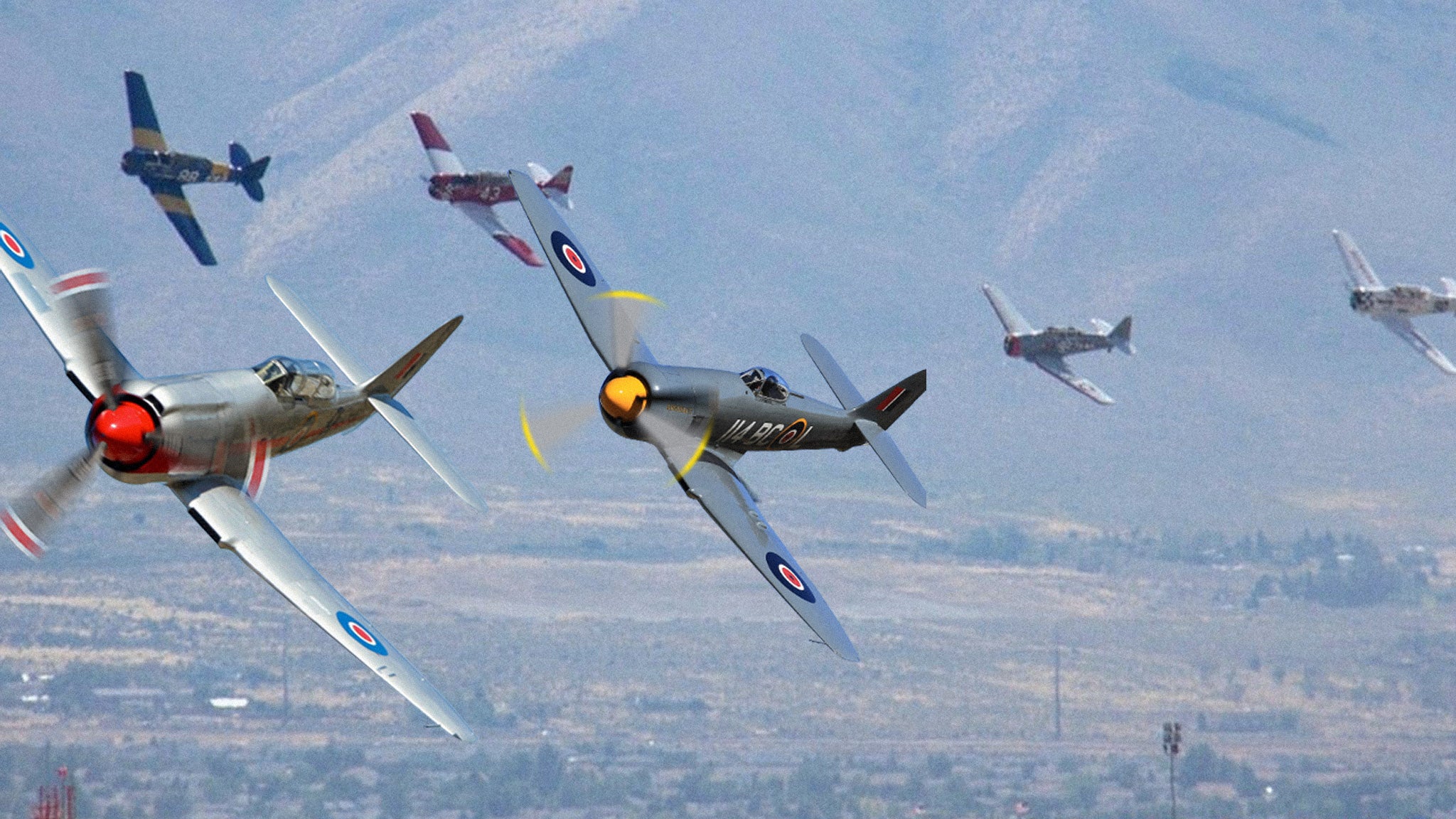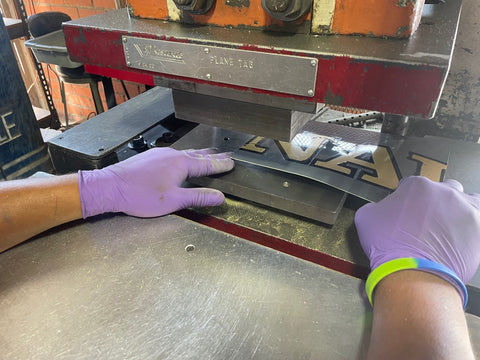
- by Dianna Lopez
Hawker Sea Fury: From Fighter to Racer
- by Dianna Lopez
A question? Visit our contact page
This site uses cookies for better user experience and analytics.

For more than 50 years, Reno, Nevada has been the host of an event that is like no other on the planet - the National Championship Air Races. This year, the MotoArt crew will be returning to Reno to celebrate and cheer on some of the fastest and most daring planes and pilots, and two Hawker Sea Furys in particular - Argonaut (#114) and Dreadnought (#8).

Hawker Sea Fury T.20S 'WG655 / 910-GN' (G-INVN) flickr photo by HawkeyeUK shared under a Creative Commons (BY-SA) license
The Sea Fury was a British fighter-bomber, developed during WWII for the Royal Navy. It was the Royal Navy’s last propeller driven fighter, and also one of the fastest single piston-engined production aircraft ever built. It was powerful, agile, and popular with those who flew them and maintained them. Over 850, in all variants, were built. They not only flew for the Royal Navy, the Royal Canadian Navy and Royal Australian Navy and other navies as carrier based aircraft, but also land based aircraft for many other nations.

Its design was similar to the Hawker Tempest, but featured a shorter wingspan and a lighter weight. It was an all metal fuselage, built in four sections, including the tail section. It also featured a wide wheel base for stability and better carrier landings. Its wings were built in three parts, and could be hydraulically folded and locked. It could also carry 200 gallons in its five internal fuel compartments, with an additional 180 gallons in under wing drop tanks.

As the jet age commenced, the Sea Fury was mostly retired from military use. Many went on to the civil aviation sector or remain flying in air shows and air races.

Hawker Aircraft Limited was a British aircraft manufacturer responsible for some of the most famous products in British aviation history. After World War I, the Sopwith Aviation Company - then a major British aircraft manufacturer - went bankrupt. Sopwith test pilot Harry Hawker, along with Thomas Sopwith and others, bought the assets of Sopwith and formed Hawker Engineering, later Hawker Aircraft Limited and Hawker Siddeley.
Some of the many Hawker aircraft include:

Hawker Fury trio. ‘SR661’ (G-CBEL), ‘VX281’ (G-RNHF) & ‘WG655’ (G-INVN) flickr photo by HawkeyeUK shared under a Creative Commons (BY-SA) license
Source Wikipedia

The celebrated Reno air races began in 1964, when Bill Stead organized an air race near Reno, Nevada. Like other famous air races of yesteryear, such as the Cleveland Air Races, the Reno Air Races became a major aviation event and an institution. Every year, aviators and enthusiasts gather in Northern Nevada for several days of thrills, roaring engines, daring pilots, and breathtaking maneuvering in incredibly fast planes. The National Championship Air Races have been taking place every year ever since, with the exception of September 2001 after the events of 911, and September 2020 during the COVID-19 pandemic. This year’s events are being held September 15 - 19, 2021.
List of 2021 Racers here. Live stream here.
If you're at the races, stop by and visit us!

The Sanders family are widely regarded as the first family of air racing and authorities on Sea Fury restoration and racing. Frank and Ruth Sanders began a family business, which later included their sons Dennis and Brian, restoring old aircraft and warbirds for customers. In 1970, they purchased a crate containing one and a half Sea Fury and parts salvaged from Canada. Frank rebuilt one, 232 which later became September Fury, and began flying in shows and races. He later restored Dreadnought and Argonaut.

#8 Dreadnought first raced at the Reno Air Races in 1983, placing first in Unlimited Gold in 1983, 1986, 2018 and 2019. She was built up from VZ386, a former Royal Navy and Burma Air Force aircraft.

Thank you Rob Schneider for the drawings of Dreadnought and Argonaut
Characteristics:
Performance:


#114 Argonaut was built from TG114, a former Royal Canadian Navy fighter, and has appeared regularly at the Reno Air Races since the 1990s, placing first in Unlimited Silver in 1997 and 2005.


Characteristics:
Performance:
MotoArt owner Dave Hall was thrilled and honored to accept material from the restorations of Dreadnought and Argonaut from Dennis Sanders. Not only was he able to fulfill his dream of adding not one but two Sea Furys to the PlaneTags collection, but to have such beloved crowd favorites and esteemed racers Dreadnought and Argonaut was unbelievable. "We're going to be holding pieces of them and watching them win at the same time," says Hall. "It doesn't get much better than that!"

Original aircraft skin from the restoration of Dreadnought and Argonaut Sea Fury air racers.

Back at MotoArt Studios in Torrance, California, the team went to work to create PlaneTags from the fuselage material which had been removed from restoration work.

The material was separated by plane and cut into smaller pieces for easier handling.

Although the photos show lettering from the aircraft names, the engravers realized quickly that they could not engrave over the sticker material.

The stickers were removed and the PlaneTags were created from the bare metal or original paint from the aircraft. Each is unique; some have rivet holes, some have an aged blue patina, but all are one of a kind and beautiful.


The Dreadnought PlaneTags are numbered to 1,500. They are available in metal, blue patina, and mixed patina variations, and with or without rivet holes. They will be a great addition to a PlaneTags collection or as a gift for an air racing or Sea Fury enthusiast.


The Argonaut PlaneTags are also numbered to 1,500. They are available in metal or metal with rivet holes.


Available at planetags.com or at the 2021 Stihl National Championship Air Races in Reno, Nevada. Stop by if you are at the races - we'd love to meet you!

From Warbird to Water Bomber: The Epic Life of the Hawaii Mars
In the world of aviation, few aircraft have lived a life as large, or as long, as the Hawaii Mars. Towering over most of its contemporaries with a wingspan of 200 feet, this mighty flying boat was born in the final days of World War II, then quietly transformed into one of the most iconic aerial firefighting aircraft the world has ever seen. From military transport to firefighting titan, the Hawaii Mars represents one of aviation’s most extraordinary second acts.
In 2025, MotoArt obtained an original wing of this aircraft and created special PlaneTags, made exclusively for the Martin family members and Mars workers. On December 11, 2025, Hawaii Mars PlaneTags will be available to the general public for the first time.
F-14 Tomcat Coasters: A Legendary Fighter Reimagined for Your Home
Few aircraft define an era quite like the Grumman F-14 Tomcat. Sleek, powerful, and unmistakably iconic, the Tomcat was the Navy’s premier fleet defense fighter for more than three decades. From Cold War missions to pop culture stardom, the F-14 remains one of the most recognizable and beloved aircraft ever built. Today, MotoArt is proud to introduce the F-14 Tomcat Coaster Set, created from authentic F-14 aircraft material.
PR-AJB: The Story of an Azul Airbus A320 With a Global Journey
Every airplane has a story, and some travel farther than others before their flying days are over. PR-AJB was one of those well-traveled aircraft. This Airbus A320 started its life flying British families on long-awaited holidays, then later crossed the Atlantic to join the growing fleet of Azul Linhas Aéreas Brasileiras. Over nearly nineteen years it picked up new registrations, new paint, new routes and a new home, carrying thousands of passengers along the way.
Its journey reflects how widely the A320 family has spread around the world and how easily these aircraft adapt to whatever their next chapter requires. PR-AJB also arrived at Azul during an important period of expansion as the airline worked to connect more cities across Brazil. In this blog we will explore where the aircraft came from, what it did during its short time with Azul, and how it eventually came to rest in Florida. We will also share how MotoArt recovered material from the retired airframe and created PlaneTags so its story can continue in a new way.


Share:
T-28C Trojan: A Trainer For A New Generation of Naval Aviators
Eastern DC 8: Welcome to the Jet Age